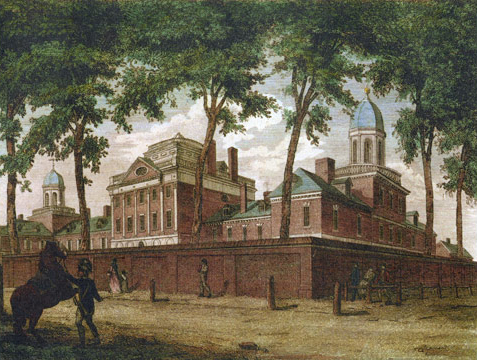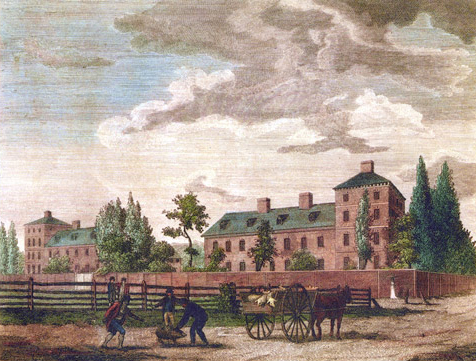Pennsylvania Hospital
Pennsylvania Hospital, on Pine Street, Philadelphia
William Birch
Above and below: courtesy Independence National Historical Park, Karie Diethorn, Chief Curator, and with the kind assistance of library technician Andrea Ashby Leraris.[1]The prints in the INHP collection, which originated in various portfolio sets that preceded Birch’s book, The City of Philadelphia, in the State of Pennsylvania North America, as it appeared in … Continue reading
In the year that the University of Pennsylvania opened its doors to students, its founder Benjamin Franklin, taking up an idea of the physician Thomas Bond (1712-1784), secured a charter for Pennsylvania Hospital. Bond had returned from his European studies impressed by the British concept of a hospital as an institution for medical care. His proposal for such an institution had not fared well until Franklin joined the effort
Among the usual devices such as gifts and subscriptions were included some novelities: a matching fund from the state of Pennsylvania and a requirement that any artisan hired had first to have offered his services as an unpaid contributor.
For forty years, beginning with its opening as the country’s first hospital in 1756, the east wing on 8th Street (at right in Birch’s engraving) housed all the patients and services of Pennsylvania Hospital. Post-war resumption of construction led to completion of the west wing in 1796 and of the central building in 1804.
Like the European charity hospitals, and unlike the Almshouse (see below) a block away at 10th and Spruce, free medical care was to be provided for the poor, though paying patients were also welcomed. Not admitted were victims of contagious disease (whether yellow fever was contagious was thus more than a theoretical issue) and “incurables” except “lunaticks.” The number of the latter had so increased that by the time work resumed, the whole west wing was reserved for psychiatric patients. Benjamin Rush‘s long campaign to bring them up from the basement had succeeded.
Almost from its beginning Pennsylvania Hospital was the teaching hospital for the University of Pennsylvania medical School. Franklin’s two institutions merged formally in 1997, more than two centuries after the founding of the medical school.
A portrait of Benjamin Rush, painted in the year of Rush’s death by Thomas Sully, today hangs just outside the hospital’s historical library.
The Alms House
The Alms House, which included an infirmary, was constructed by the City of Philadelphia in 1760-67 to replace the cottages that the Society of Friends (Quakers) had provided for indigent immigrants as early as 1713. The House of Employment or “workhouse,” where all recipients of charity were encouraged to donate their skills, was built at the same time. Both were razed in 1834-35 after changing conditions had required the erection of larger facilities across the Schuylkill River in West Philadelphia.
Experience the Lewis and Clark Trail
The Lewis and Clark Trail Experience—our sister site at lewisandclark.travel—connects the world to people and places on the Lewis and Clark Trail.
Plan a trip related to Hospital and Alms House:

Notes
| ↑1 | The prints in the INHP collection, which originated in various portfolio sets that preceded Birch’s book, The City of Philadelphia, in the State of Pennsylvania North America, as it appeared in the Year 1800, measure approximately 18 by 14½ inches. |
|---|


